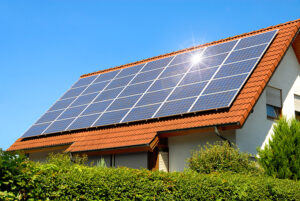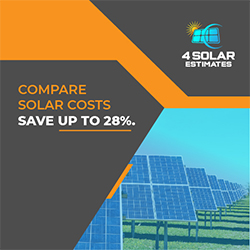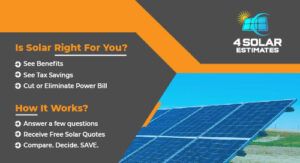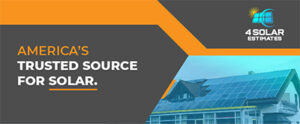
How Many Solar Panels are Needed to Run a Home?
If you’re considering installing solar panels in your home, one of the first questions you’re likely to have is how many panels you’ll need. The answer depends on a number of factors, including the size of your home, your energy usage, and the efficiency of the panels you choose. In this article, we’ll take a closer look at how many solar panels are needed to run a home, and what factors you should consider when planning your solar panel installation.
COMPARE SOLAR QUOTESUnderstanding Your Energy Usage
The first step in determining how many solar panels you’ll need is to understand your energy usage. You can do this by looking at your energy bills over the past year and calculating your average monthly usage. This will give you a baseline for how much energy you need to generate with your solar panels.

Estimating Your Solar Panel Needs
Once you know how much energy you need to generate, you can start estimating how many solar panels you’ll need. A typical solar panel can produce between 250 and 400 watts of electricity, depending on its size and efficiency. To determine how many panels you need, you’ll need to divide your average monthly energy usage by the wattage of each panel.
For example, if your average monthly energy usage is 1,000 kWh, and you’re using 300-watt solar panels, you would need around 11 solar panels to generate enough energy to power your home.
Factors That Affect Your Solar Panel Needs
While the above calculation provides a general estimate of how many solar panels you’ll need, there are several factors that can affect your actual needs. These include:
- Your Home’s Location: The amount of sunlight your home receives can vary depending on your location, so homes in sunnier areas may need fewer panels.
- Your Home’s Energy Efficiency: Homes that are more energy-efficient will require less energy overall, which can reduce the number of panels needed.
- Your Solar Panel Efficiency: More efficient solar panels can generate more electricity per panel, reducing the number of panels needed to power your home.
- Your Energy Usage Habits: If you use a lot of energy during peak hours or have high energy needs, you may need more panels to generate the amount of energy you need.

Solar Panels Per Square Foot
The number of solar panels you’ll need can also vary depending on the size of your home. A typical solar panel is around 17 square feet in size, so you’ll need approximately 100 square feet of space for every 6 solar panels. This means that if you have a smaller roof, you may need to use more efficient panels or install them in a different configuration to generate the energy you need.
Overall, the number of solar panels you’ll need to power your home will depend on a variety of factors. By understanding your energy usage, considering the efficiency of your panels, and taking into account other factors that can affect your solar panel needs, you can make an informed decision about how many panels to install. Whether you’re looking to save money on your energy bills or reduce your carbon footprint, solar panels can be a great investment for your home.
COMPARE SOLAR QUOTESWhat are the 3 Main Types of Solar Panels?
If you’re considering installing solar panels on your home, you may be surprised to learn that there are several different types of solar panels available. While all solar panels work by converting sunlight into electricity, each type has its own unique advantages and disadvantages. In this article, we’ll take a closer look at the three main types of solar panels: monocrystalline, polycrystalline, and thin film.
Monocrystalline Solar Panels
Monocrystalline solar panels are made from single-crystal silicon, which gives them a uniform, sleek appearance. They are known for their high efficiency and longevity, with some panels lasting up to 25 years or more making them one of the most long-lasting types of solar panels. Monocrystalline panels are also very efficient at converting sunlight into electricity, making them a popular choice for homeowners with limited roof space.
One potential downside of monocrystalline panels is their cost. They tend to be more expensive than other types of solar panels, which can make them less accessible for homeowners on a tight budget.

Polycrystalline Solar Panels
Polycrystalline solar panels are made from multiple silicon crystals, which are melted together to form the panel. They have a distinctive blue color and a slightly lower efficiency than monocrystalline panels. However, they are generally more affordable than monocrystalline panels, making them a good choice for homeowners looking to save money.
Thin Film Solar Panels
Thin film solar panels are made from thin layers of amorphous silicon, which make them flexible and lightweight. This makes them easy to install on rooftops or other surfaces that may be difficult to mount rigid panels onto. They also have the highest temperature tolerance of any type of solar panel, which makes them ideal for hot climates.
- On average, monocrystalline solar panels cost between $0.50 and $1.00 per watt of power generated, so a 6kW system would cost around $3,000-$6,000.
- Polycrystalline solar panels will range between $0.30 and $0.70 per watt of power generated, so a 6kw system would cost around $1,800-$4,200.
- Thin film solar panels generally cost between $0.10 and $0.30 per watt of power generated, so a 6kw system would cost around $600-$1,800.
- In addition to the cost differences, each type of solar panel has its own advantages and disadvantages that should be considered when making your decision.
Overall, the type of solar panel you choose will depend on your budget and needs. Monocrystalline panels offer the highest efficiency but are more expensive, while polycrystalline panels provide good performance at a lower cost. Thin film solar panels are great for tight spaces or hot climates, but may not be as efficient as the other types of panels. Consider all your options before making your decision to ensure you get the best return on your investment.
COMPARE SOLAR QUOTES
Leave a Reply